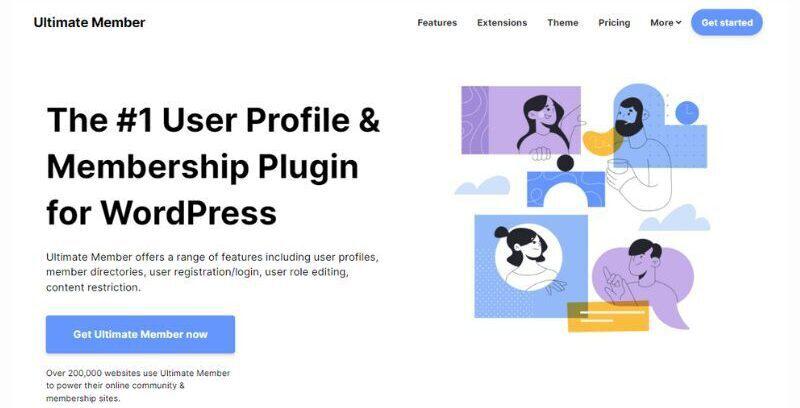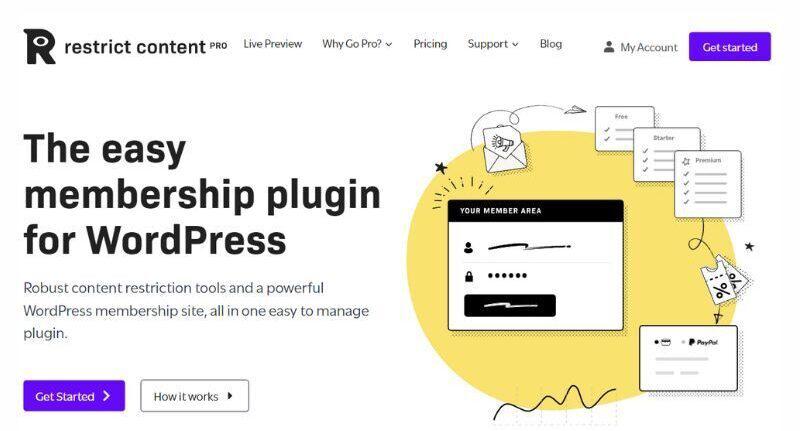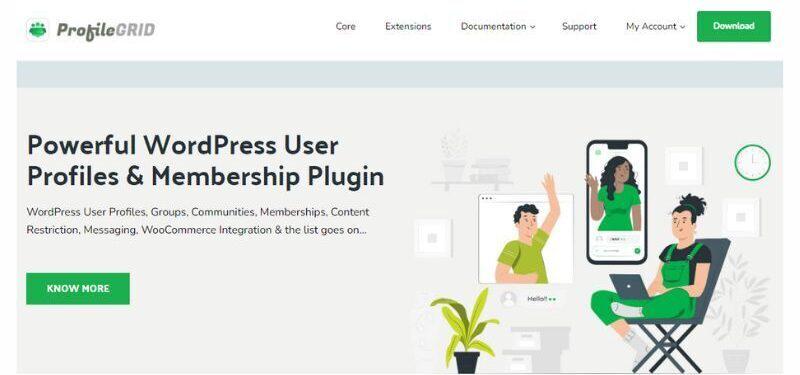Bringing your website to its maximum potential either for business or social community would need extensive user engagement. One of the simplest ways to do it is to build a membership website.
Whenever this is something that you’re currently focusing on, the article will give you some information and insight into why running a membership website is a good solution to increase user engagement and the best selection of WordPress plugin for membership websites.
What is a Membership Website?
Websites that are built on a membership platform, offer content or features exclusivity to visitors. A web visitor who wants to access more features, details, and probably web tools on a membership website is required to sign up to become a member.
By enabling the sign-up as members functionality for the web visitors, you can motivate them to stay engaged with your web content and updates.
A well-maintained membership website will build trust and give the members a sense of appreciation while using your service or products along with continuing to get useful content regularly.
A business-oriented membership website usually offers subscription plans on a monthly or yearly basis for access to exclusive content. The subscription can be available in a few options and the most exclusive access is given to the highest member level who has subscribed.
As for a non-profit business or organization, running a membership website will give more opportunities for user interaction. Sharing support between members and moderators would also be easy and flexible to maintain.
Why Should you build a Membership Website?

Website Monetization

Increasing the User Engagement

Increasing the Web Traffics

Offering Exclusive Content

Create a Stronger Community Support
1. Website Monetization
It allows offering exclusive content for instance: extended features, articles, tutorials, or full access to web tools based on subscription plans. The subscription is often being offered as a trial plan for the user or member to see if the exclusive content is right for them before deciding to buy one of the subscription plans.
The free members could have the chance to buy a paid-subscription plan gradually after some time as they might need more exclusive access or content to fit their needs, or they can get a trial offer to experience the exclusive features for a limited time. This is one of the effective monetization strategies that membership websites can get.
2. Increasing the User Engagement
Any promotional campaigns on the membership website would normally be accessible upon registration for a new member. This will accordingly increase user engagement to the upcoming new web content updates or any other promotional campaigns in the future.
An online social community that is built on a membership platform provides ways to share information with members, between members, and even with potential new members. These interactions would ensure its exponential growth.
3. Increasing the Web Traffics
Loyal members will likely visit a website regularly for new content and give more exposure to the website. Especially when happy members share their experiences and recommend benefits, useful content, services, or products on social media websites.
4. Offering Exclusive Content
Membership platforms make it easy to share exclusive content based on the membership plans. Free members normally will have limited access to exclusive content, compared to the paid users or members in different subscription plan levels.
5. Create a Stronger community support
Besides increasing user engagement, membership websites make possible easy interaction between the members and administrators. This interaction will create stronger community support and trust through instant messaging or community forums.
6 Things to Consider When Choosing a WordPress Plugin for Membership Website
1. Tracking Tools for Administrators
The monitoring, settings option, and tracking tools on the plugin admin dashboard would often include:
- Users Role editor & membership moderation
- Content restriction management
- Billing & subscription settings
- Additional settings if there are any, such as download monitoring, security, and integration settings
2. Membership Features & Functionalities
These are some common features and functionalities of the WordPress membership plugin:
- Customizable user profile
- Frontend customization settings
- Support multiple members or group directories
- Multi-language support
3. Content Management & Restriction
One of the main functions of membership websites is to limit content access for users. This can be done in the following ways:
- By user roles or by membership types
- Block or lock exclusive content for trial or free membership account
- Offer drip content
4. Billing & Subscription Options
The key component in membership website monetization is the billing and subscription options, which include:
- Multiple payment & subscription options for different types of membership accounts
- Flexible pricing models
- Custom billings and invoicing
- Membership renewal system
5. Security Features
The membership website security usually provides:
- Login Security
- Protection for malicious users
- Payment process security
- User verification
6. Integration Options
Rich integrations ensure flexibility to expand the membership website development. Examples of integration to add-ons, extensions, or third-party apps are as followings:
- Marketing add-ons (Affiliate, Mailing List, Subscription, etc)
- eCommerce extensions WooCommerce, Authorize.net, PayPal, Stripe, etc.).
- Community Builder (Group membership, bbPress, BuddyPress, etc.)
- Events Manager (Event Prime, Events Manager, The Events Calendar, Sugar Calendar, and All-in-One Event Calendar)
- Page Builder (Gutenberg Block, Elementor, Divi, etc.)
- Learning Management System (LearnDash, Lifter LMS, etc.)
6 Most Recommended WordPress Plugins for Membership Websites
WordPress CMS is quite flexible to develop as various types of websites because of the availability of a great number of plugins, and there are many powerful WordPress plugins designed for membership websites. Here are the most recommended plugins with highlighted features to check and compare:
1. MemberPress

More than 200.000 WordPress installs, MemberPress is one of the most popular membership plugins that has multi-features to create a membership website with powerful monetization functionality, all in one.
The Pros and Cons
Pros
Cons
MemberPress Free version:
Members – Membership & User Role Editor Plugin
2. Ultimate Member

The next most popular membership plugin is Ultimate Member. The plugin’s main functionality is focused on User Profile & Member Directory with many frontend settings and options which allow interaction between users.
The Pros and Cons
Pros
Cons
Ultimate Member Free version:
Ultimate Member – User Profile, User Registration, Login & Membership Plugin
3. Paid Memberships Pro

Paid Membership Pro offers many customization options to build a membership or online course website with full monetization functionalities that can also be extended into a community website.
The Pros and Cons
Pros
Cons
Paid Membership Pro free version:
Paid Memberships Pro – Restrict Member Access to
Content, Courses, Communities – Free or Paid Subscriptions
4. Restrict Content Pro

Restrict Content Pro focuses on Content Management with many content restriction options. The features are pretty straightforward but fairly functional for a simple membership website.
The Pros and Cons
Pros
Cons
Restrict Content Pro free version:
WordPress Membership Plugin – Restrict Content
5. S2Member

If you’re looking for a simple membership plugin to limit content access with a very strong security setup, S2Member would be the best choice.
The Pros and Cons
Pros
Cons
S2Member free version:
s2Member® Framework (Membership, Member Level Roles, Access Capabilities, PayPal Members)
6. ProfileGRID

The last membership plugin recommendation is ProfileGRID which probably less popular but it’s extendable and easy to customize to build a membership website where members can socialize in many ways within a group.
The Pros and Cons
Pros
Cons
ProfileGRID free version:
ProfileGrid – User Profiles, Memberships, Groups, and Communities
Conclusion
Before choosing the right WordPress plugin for a membership website, first of all, it’s crucial to check the plugin’s main features or functionalities, and consider who would be the website members as these would affect the membership models in general, especially the user experience.
Secondly, seeing through the monitoring dashboard and the plugin’s tracking system would ensure how manageable the controls on the plugin are. The next thing to consider is how the plugin would take care of the content restriction, billing, and subscription to get maximum eCommerce functions as needed.
It’s also important to check the plugin’s security system as it will result directly in the website's performance. The last thing would be how the plugin would be easy to integrate into any third-party apps, add-ons, or extensions to fit the membership system and any possible future development of new ideas.
Finally, check if the plugin offers customization options so it will give freedom to build a more personalized membership website. The customization options also make it easy to fit the specific requirements to run a membership website.
Frequently Asked Questions
What is the best WordPress migration plugin?
Some of the best WordPress migration plugins are Bluehost Migrator, Migrate DB Pro, BackupBuddy, Migrate Guru, JetPack, Duplicator, and more.
Are WordPress plugins free?
WordPress has loads of plugins you can install, some of them are free, but some of them you will need to pay for. You can learn how to use WordPress Plugins on our blog.
Why choose hosting for WordPress?
WordPress is so popular because it allows people to create websites with total customization. With hundreds of apps available for one-click installations, creating something that’s eye-catching and unique is much easier with a CMS like WordPress .
Who should use hosting for WordPress?
First of all - people using CMS WordPress

Audee Mirza is a graphic designer and WordPress developer at audeemirza.com who resides in Surabaya, Indonesia. She's also the author of Graphic Identity Blog, a professional logo designer, and often creates vector illustrations for clients and marketplaces. She enjoys good typography design and all kinds of animation.
View all posts by Audee Mirza



















